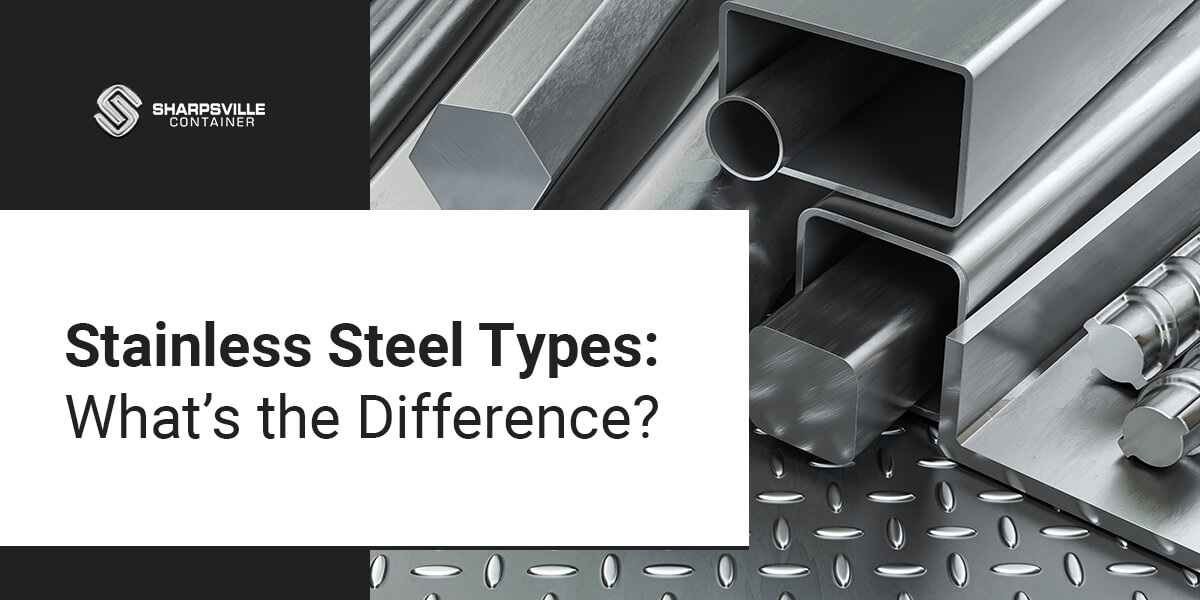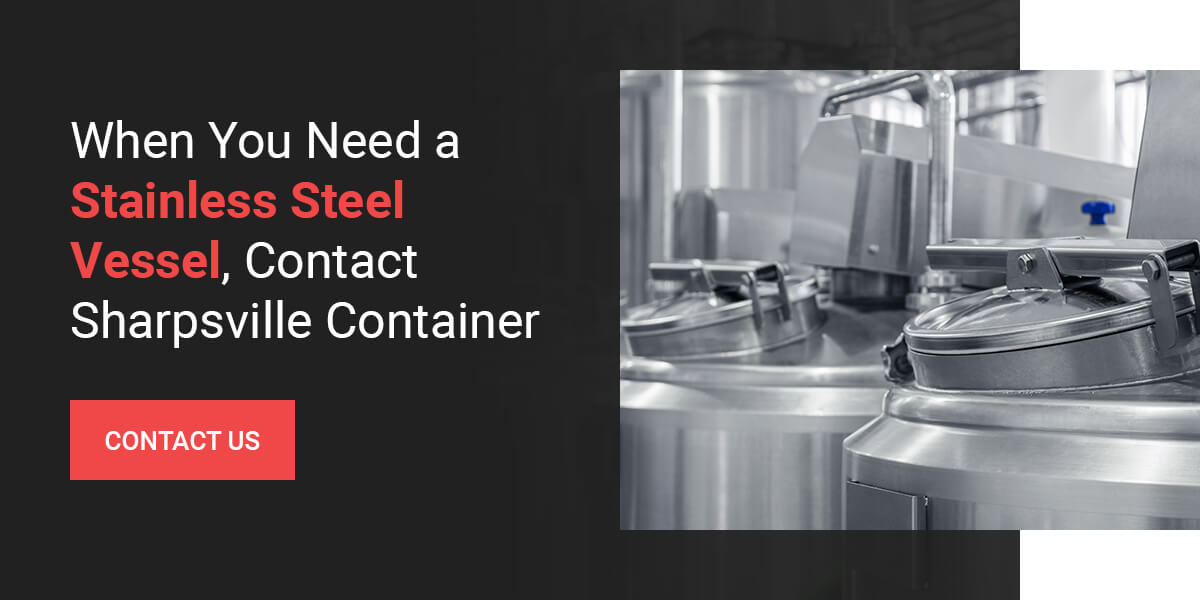Stainless Steel Types: What’s the Difference?

Table of Contents
- Stainless Steel Types
- Common Stainless Steel Grades
- Best Types of Stainless Steel by Industry
- How to Choose the Right Type of Stainless Steel
- Choosing a Stainless Steel Vessel Manufacturer
Most people have heard of stainless steel, but many don’t know that more than one type of stainless steel exists, and each type is particularly useful for certain industries and commercial purposes. Stainless steel provides:
1. Reliable and safe construction materials for buildings.
2. Dependable and clean storage facilities for food and beverages.
3. Items for everyday consumers, like stainless steel cookware, cutlery and beverage containers.
In this stainless steel type comparison guide, we focus on the material’s industry uses. We’ll look at the different types of stainless steel, how they are created and the purposes to which they are uniquely suited. We’ll examine the advantages and disadvantages of the different types and how industries have used them to their advantage.
In particular, we will look at the material’s use in vessel production, specifically vessels in which you store liquids, corrosive materials or foodstuffs.
Stainless Steel Types and Grades Used in Vessel Production
Stainless steel is far more corrosion-resistant and durable than other iron-based metals. It is not composed of a single metal but an alloy of several elements melted together. Its main component is iron, along with a small amount of carbon.
While there are more than 100 grades of stainless steel, we will focus on a few types. Stainless steel falls into four different metallurgical groupings:
1. Austenitic
Austenitic stainless steel is infused with a high chromium concentration during the production phase. It’s more corrosion-resistant than other types, making it the most popular stainless steel alloy.
Items made from austenitic stainless steel have the unique property of being nonmagnetic except during a cold-forming process — a forging technique that shapes metals at room temperature.
2. Ferritic
This type of stainless steel material has a lower nickel content than most other types, which makes it less expensive. It has magnetic properties and can be hardened during cold-forming processes.
3. Martensitic
Martensitic stainless steel is the least popular type of stainless steel alloy, as it’s mostly used when an item requires high impact resistance or when production requires high tensile strength. It’s typically layered with a protective polymer coating, which provides excellent corrosion resistance.
4. Duplex
Duplex stainless steel is created with a higher chromium content. It has a lower nickel content than other types of steel alloys. This combination makes it stronger and more affordable.
Producing duplex stainless steel calls for nearly equal proportions of austenitic and ferritic steel. This construction gives it excellent corrosion-resistant properties. Duplex stainless steel is commonly used in risers in offshore oil rigs.

Common Stainless Steel Grades
Two grades of the austenitic family — 304 and 316 stainless steel — are the most popular. They’re incredibly strong and corrosion-resistant, making them useful in various industries. The 316 grade is particularly useful for products designed for use by food and beverage operations.
304 Steel
This is the most globally used stainless steel. Many industries prefer 304 for its excellent cost value and corrosion resistance. The most widely used form contains about 18% chromium, but this percentage can range anywhere from 16% to 24%. It also contains about 8% nickel. It can’t be stained by the organic chemicals you find in food processing, and it’s highly resistant to many inorganic chemicals.
304 stainless steel is a cost-effective and suitable choice for most work environments. It performs well in kitchens and anywhere else you need to prepare or store food. You can also use it in building construction, stainless steel decorations favored by some designers, furnishings and, for our purposes, vessel construction.
304 stainless steel is not recommended for use near salt water, such as the kind you might find on the coastline. That’s because while 304 is highly corrosion-resistant, it can react with chlorides and the saline environment found near the ocean. So, if your business is located on the coastline and you need a large stainless steel vessel to store important foodstuffs, liquids or chemicals, 304 steel is not recommended. You could end up with pitting corrosion.
You might also consider a different steel grade if your business is located near a road or area that is heavily salted in the winter. Choose a steel that reacts more favorably to chlorides and other solvents.
316 Steel
There isn’t much difference between 316 and 304 stainless steel grades. They have almost identical physical and mechanical properties. However, 316 steel includes 2% to 3% molybdenum and a bit more nickel. This makes 316 stainless steel far more resistant to the chlorides that undermine 304. It’s ideal for use in regions near the coast and any area where deicing salts get substantial use. This makes it perfect for marine applications.
316 steel is a great choice for any acidic environment. It provides excellent corrosion protection against many acids and alkaline chlorides.
It is easy to maintain and has excellent creep strength, meaning it’s much more resistant to industrial stresses. The addition of molybdenum also makes 316 steel ideal for surgical instruments. One of 316’s few drawbacks is that it doesn’t respond well to welding.

Other important stainless steel varieties to note for vessel production include:
- 316L steel: This is an excellent stainless steel for storage tanks that hold corrosive materials. It offers superb corruption resistance, greater creep strength than 316 and little metallic contamination. Like 316, it doesn’t harden under heat treatment. The difference between 316 and 316L is carbon. There is more of it in 316. The L in 316L stands for “low carbon.” This is the most suitable type for welding.
- Nickel alloy: Nickel alloys resemble stainless steel but have a higher nickel content. This also gives them a greater corrosion resistance, making them ideal for use in chemical storage and transportation.
- Carbon steel: Carbon steel contains no chromium, so it has a rather dull finish compared to the shiny finish of stainless steel. It can corrode more easily than stainless steel, but its lower cost makes it ideal for situations where steel is out of view. It could be an excellent choice if you work in a relatively noncorrosive environment and if your vessel or silo is not visible to the public.
Best Types of Stainless Steel by Industry
All of the different types of stainless steel are excellent for corrosion protection, but the ideal grade depends on what you will use the vessel for and where you will use it:
What Is the Best Stainless Steel Grade for the Chemical Industry?
If your business involves the storage or transportation of hazardous chemicals and other such materials, use 316 steel due to its stronger anticorrosive properties. This is particularly the case with acids. If you need an irregularly sized vessel or storage container, 316L may be your best bet because it can be welded safely and maintain its creep strength. Another possible choice for chemical storage is a nickel alloy vessel.
What Is the Best Stainless Steel Grade for Commercial Food Preparation?
Because of their resistance to organic and nonorganic compounds, 300 grades are used widely in commercial food preparation. Whether you are storing liquids like milk or solids like grains or corn, a stainless steel silo or vessel composed of 304 or 316 is a good choice. The strength, durability and noncorrosive qualities of these stainless steels also make them ideal for use in either small or large vessels and containers. A 304 steel is very usable and will suit many purposes. But as noted above, if you work in an environment with high saline content, anywhere near the coastline or near a frequently de-iced road or parking lot, go with a 316 steel vessel.

What Is the Best Stainless Steel Grade for the Beverage Industry?
In the beverage industry, the right stainless steel depends on the beverage being stored. Liquids like soft drinks or spirits could probably be stored in a vessel composed of 304 steel. 316 steel will not react to acids and alkalis found in milk and many other food components that could be stored in a vessel or silo. If your storage tanks are in a facility where they won’t be publicly viewed, you might look into carbon steel vessels. But the advantage of 304 and 316 is that they can be easily and repeatedly cleaned to high standards.
What Is the Best Stainless Steel Grade for the Water Purification Industry?
Stainless steel vessels and containers are best for potable and non-potable water storage. All of the 300 stainless steel grades, as well as the nickel alloy and carbon steel varieties, could be used. The important questions to consider are cost and location.

How to Choose the Right Type of Stainless Steel

Consider these factors to select the best stainless steel for your products:
1. Operating Environment
The environment in which your product will be used greatly affects the type of stainless steel you should choose. It should have the properties to withstand temperatures, stressors and potentially corrosive situations.
Of course, stainless steel’s anti-corrosive properties make it a versatile pick for various environments, from food and beverage to construction. However, its performance still depends on the processing space.
If the operating environment has a broad temperature range, austenitic stainless steel is the right option, but in a marine environment, you’ll need a chloride ion-resistant alloy like duplex.
2. Cost Factor
It’s wise to make a decision based on factors other than cost, as the cheapest choice may cost more for maintenance and repairs in the long run. However, some projects require less expensive options, so they opt for ferritic and duplex stainless steel.
Austenitic stainless steels are typically the most expensive because they offer some of the best properties for various industries, like strength, durability and high chromium.
3. Strength and Magnetic Response
The stainless steel type you choose should be strong enough to withstand the required amount of weight without fracturing or deforming. It should also deform and absorb energy before it fractures to ensure extra protection.
Most stainless steels contain 10%-30% chromium, which prevents corrosion. Low-nickel types like ferritic aren’t the strongest options, so it’s best to go with austenitic or martensitic grades for the strongest and most impact-resistant items.
In terms of magnetic response, more chromium equals greater magnetic properties. More nickel means less magnetic properties.
4. Formability and Ductility
If the manufacturing process requires high formability, you should avoid martensitic stainless steel, as it could crack when welding or forming. Opt for austenitic or ferritic steel for high-formability projects, as they’re typically easier to weld and maneuver.
The addition of nickel in certain austenitic grades delivers the best ductility and toughness, so ferritic and duplex don’t perform well in this category.
5. Corrosion Resistance
Some environments have harsh conditions that can rapidly corrode stainless steel items. High-chromium stainless steel types, like austenitic grades, offer the most effective corrosion resistance.
Choosing a Stainless Steel Vessel Manufacturer
Choose a stainless steel vessel manufacturer that can provide you with materials that meet your specifications and standards. Look for these key characteristics when making a selection:
- An in-house engineering team
- An ISO 9001-certified, NSF-approved company
- At least a 12-month warranty on products and fittings
- Industry experience and a good reputation
- Technical support on storage, handling and maintenance
Make Sure Your Manufacturer Has These Options Available
Whether you need a vertical silo, large tank or another type of vessel to store chemicals, food or beverages, sit down with your chosen manufacturer and review your options.
It’s important to discuss the value, durability and corrosion protection the different types of tank steel offer. If money is important and you can build or store your tanks in a more secluded location, carbon steel may be your best choice. If your tanks are more visible to the public, you want them to look better, and it’s hard to beat the look of a quality stainless steel tank.
If you need to store chemicals, your manufacturer should understand your industry and the difficulties you face. Ensure the manufacturer has quality testing in every step of the vessel’s construction. With chemicals, you can’t afford shoddy workmanship. Your tanks or vessels need to meet the highest industry standards.
Some questions you might ask include:
– What would you recommend as the best type of stainless steel or alloy for my particular need?
– Can you give me a cost comparison between the different types of stainless steel?
– How long will it take you to construct the vertical silo or vessels that I need?
– What if I have a specific design in mind? Can you do that? How does that affect the cost and the delivery time?
– Can you tell me a bit about your quality control process?
– Can you show me some examples of your past work or give me the names of some previous customers that I can contact?
– As someone who is researching the different types of stainless steel for tanks, don’t be afraid to ask any question that concerns you. It’s important for you and your business to make the best possible decision about materials.
When You Need a Stainless Steel Vessel, Contact Sharpsville Container
When you need a well-constructed stainless steel vessel, Sharpsville Container offers the necessary expertise and knowledge.
Our excellent engineering and design team can construct standard and custom solutions for customers around the world. We’ve been fabricating steel since the 1860s, shifting our focus in 1990 to concentrate on making the finest stainless steel vessels available on the market.
Our decades of experience give us a solid grasp of what many industries are looking for, and we aim to give them the finest possible product for their needs. We have the flexibility to produce vessels made from various steel and alloy materials.
If you have any questions, you can call us at 1-800-645-1248 or visit our contact page, where you can provide details about your business’s needs and get a no-obligation quote. A member of our experienced and qualified staff will be in touch as soon as possible, and we can also meet face-to-face at your facility to discuss solutions for your processing needs. We look forward to the chance to create new relationships with new customers.






